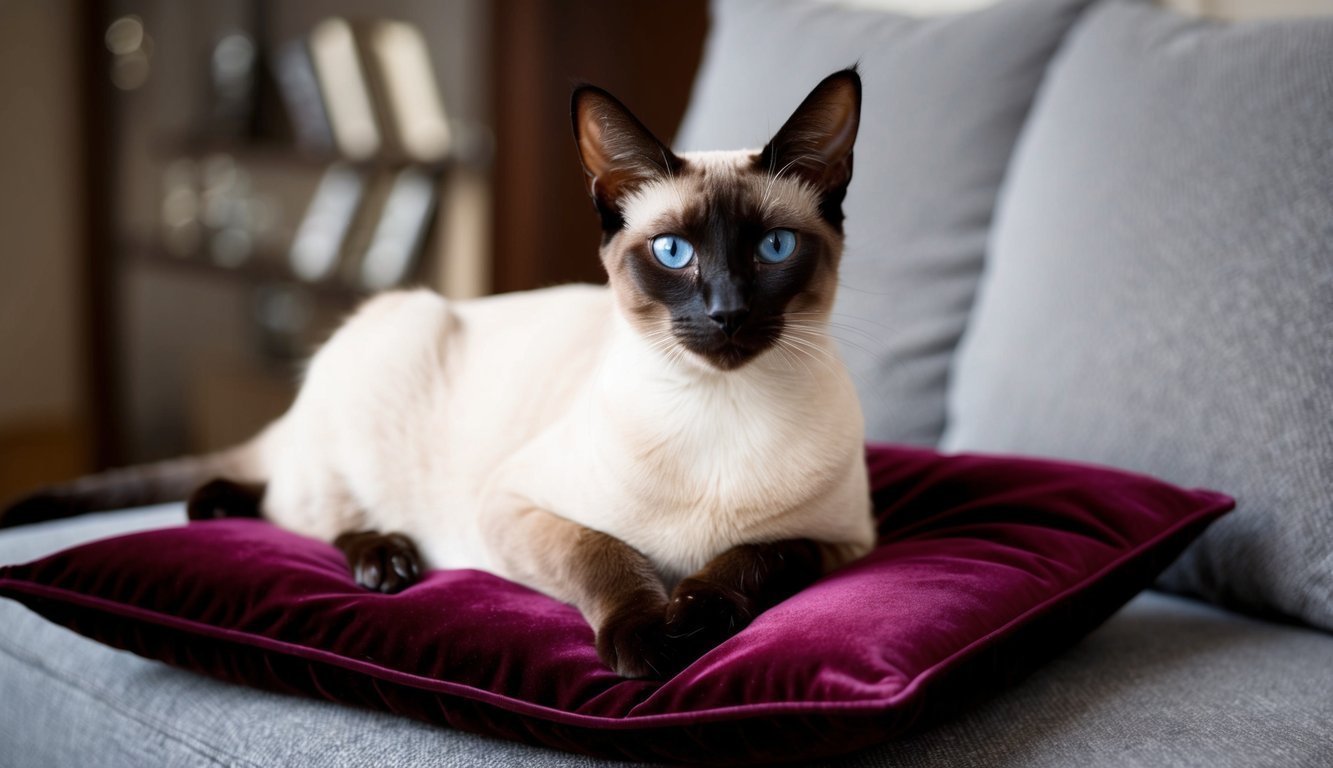Siamese cats are some of the most striking and beloved felines around.
With their sleek bodies, big blue eyes, and unique color patterns, they’re hard to miss.
These cats originally came from Thailand, which used to be called Siam.
That’s where they got their name!
There are four main types of Siamese cats: seal point, chocolate point, blue point, and lilac point. Each type has a light-colored body with darker “points” on their faces, ears, paws, and tails.
The difference is in the color of those points.
Seal points are dark brown, chocolate points are lighter brown, blue points are grayish, and lilac points are a pale pinkish-gray.
Besides these color types, you’ll also find different body shapes in Siamese cats.
Some have rounder faces and stockier bodies, while others have slim bodies and wedge-shaped heads.
No matter which type you prefer, all Siamese cats are known for being smart, chatty, and very affectionate with their humans.
History and Origin
Siamese cats have a rich history going back centuries.
You’ll find their roots in Thailand and see how they became popular worldwide.
Ancient Roots in Thailand
Siamese cats come from Thailand, which used to be called Siam.
They were special pets for Thai royalty.
The cats showed up in an old book called Tamra Maew.
This book had pictures of different Thai cats.
Royal families loved these cats.
They thought the cats could protect their souls.
When important visitors came, the royals would give them Siamese cats as gifts.
These cats lived in temples too.
Monks took care of them.
People believed the cats brought good luck.
Development and Recognition
In the late 1800s, Siamese cats came to Europe and America.
People fell in love with their looks and personalities.
Cat lovers started breeding them carefully.
The first Siamese cat club formed in England in 1901.
This helped set standards for the breed.
Breeders worked to keep the cats’ special traits.
Over time, cat shows became popular.
Siamese cats often won prizes.
This made more people want them as pets.
Today, you can find Siamese cats all over the world.
They’re still one of the most loved cat breeds.
Physical Characteristics
Siamese cats have some striking features that set them apart.
You’ll notice their unique look right away, from their pointed coloring to their athletic build.
Distinctive Features
Siamese cats have a sleek, muscular body with long legs and a thin tail.
Their head is wedge-shaped with big, almond-shaped blue eyes that slant slightly.
Large, pointed ears sit high on their head.
Some Siamese may have crossed eyes or a kinked tail.
These were once common traits but are less seen in modern breeding.
Their coat is short and silky, laying close to the body.
Color Variations
The Siamese’s coat is light-colored with darker points on the face, ears, paws, and tail.
As kittens, they’re born creamy white.
Their points darken as they grow.
You’ll see four main color varieties:
- Seal point: Dark brown points
- Chocolate point: Milk chocolate brown points
- Blue point: Gray-blue points
- Lilac point: Pale, pinkish-gray points
The contrast between body color and points can vary.
Some Siamese have more dramatic coloring, while others are more subtle.
Types and Breed Standards

Siamese cats come in different varieties with distinct features and color points.
The breed has changed over time, leading to different looks and standards.
Traditional vs. Modern Siamese
Traditional Siamese cats have rounder faces and bodies.
You’ll notice their apple-shaped heads, chubby cheeks, and stockier builds.
These cats look more like the original Siamese from Thailand.
Modern Siamese have a sleeker look.
You’ll see long, lean bodies and wedge-shaped heads.
Their ears are large and pointed.
This style became popular in the 1950s and 1960s.
Some cat lovers prefer the old-style Siamese.
Others like the newer look.
Both types can make great pets.
Recognized Color Points
Siamese cats are known for their colored “points” on a light body.
The main colors are:
- Seal Point: Dark brown, almost black
- Chocolate Point: Milk-chocolate brown
- Blue Point: Gray-blue
- Lilac Point: Pale, pinkish-gray
These colors show up on the face, ears, paws, and tail.
The body stays a creamy white or pale fawn color.
Some groups accept other point colors too.
You might see red, cream, or tabby points.
But the four main colors are the most common in shows.
Behavior and Care

Siamese cats are known for their unique personalities and specific care needs.
They make great pets but require attention to thrive.
Personality and Temperament
Siamese cats are super friendly and love being around people.
You’ll find your Siamese following you from room to room, always wanting to be part of the action.
They’re very talkative too – expect lots of meows and chirps throughout the day!
These cats are smart cookies.
You can teach them tricks and even play fetch.
They enjoy puzzle toys that challenge their minds.
Siamese are playful and active.
Make sure you have plenty of toys and climbing spots to keep them busy.
They don’t like being left alone for long, so consider getting two if you’re away a lot.
Health and Grooming
Siamese cats generally stay healthy, but they can have some breed-specific issues.
Keep an eye out for:
- Eye problems
- Respiratory issues
- Dental problems
You must schedule regular vet check-ups to catch any health concerns early.
Grooming your Siamese is pretty easy.
Their short coat doesn’t need much work.
Brush them once a week to keep their fur shiny and reduce shedding.
Trim their nails every few weeks and clean their ears as needed.
Siamese cats love to eat.
Feed them a high-quality cat food with lots of protein.
Be careful not to overfeed, as they can gain weight easily.
Exercise is important for these active cats.
Play with them daily using interactive toys to keep them fit and happy.


